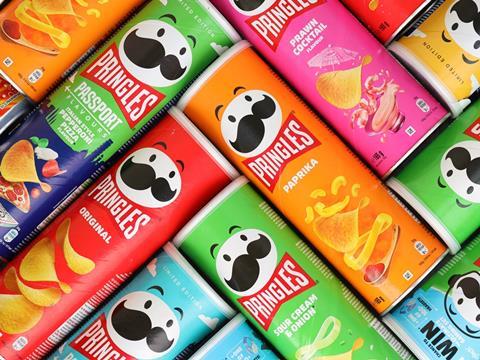
This content was originally sent to Packaging Europe members in The Bulletin – a weekly newsletter with articles like this, as well as lots more original content. To receive a brand-new edition of The Bulletin every week, plus an exclusive range of reports, briefings and events, click here.
All the way back in 2017, UK Recycling Association CEO Simon Ellin branded the old-school Pringles can the “number one recycling villain”. Its various paperboard, foil, plastic, and metal components were deemed impossible to separate and, therefore, almost entirely unrecyclable.
Six years later, as eagle-eyed readers picked up on during the nomination period for our Readers’ Award 2023, the Belgian Engineering and R&D teams at Kellogg’s (now Kellanova) and Fost Plus had come together to develop a 90% paper Pringles tube.
Consumers are directed to recycle the body of the tube with paper and cardboard. Where the traditional steel base once stood in the way, a paper fibre alternative has now been sealed onto the bottom of the pack.
“Unlike the seaming process, which relies on mechanical mechanisms, the sealing process involves the polymerization of polyethylene,” explained Seàn Cairns, president of Sonoco’s Global Rigid Paper and Closures division. “To bring this innovative concept to life, Sonoco developed groundbreaking equipment specifically designed for this closing technology.”
The remaining 10% of the pack is an inner liner made of foils and films, he elaborated. Serving as a barrier against materials, gas, and humidity, it is believed to keep the crisps crunchy for 15 months before opening.
Sustainability manager Europe Peter Görlitz specified in a LinkedIn comment that the empty tube is pulped in a pulper, and then processed further; the remaining liner exits via a coarse reject outlet. In theory, this makes the sealed layers separable.
Yet doubts were raised as to whether the remaining material is subsequently recycled, or whether the process is even effective in practice. Mike Lutz, principal packaging engineer at Boston Scientific, argued that foil liner is a contaminant during hydropulping; and several others felt that anything short of completely mono-material cannot be called recyclable.
Still, Kellanova anticipates that all its packaging will be recyclable, reusable, and/or compostable by 2025, and the rollout continues. To prepare for the annual production of over one billion sealed tubes, every Pringles production line in Mechelen, Belgium was installed with new machinery last summer.
The new tubes launched exclusively at Tesco, One Stop, and online in January, and just last month extended to Ireland following a €100 million investment in new technology.
No one has mourned the removal of the steel base, to my knowledge, so even in the worst-case scenario, the redesign is not a complete write-off. As for the rest of the pack, we will undoubtedly learn more about its performance as more tubes are distributed and discarded. I, for one, will be keeping my eye on its progress.
If you liked this story, you might also enjoy:
The ultimate guide to the Packaging and Packaging Waste Regulation in 2024
How are the top brands progressing on packaging sustainability?
Sustainable Innovation Report 2024: Current trends and future priorities
Everything you need to know about global plastic sustainability regulation












No comments yet